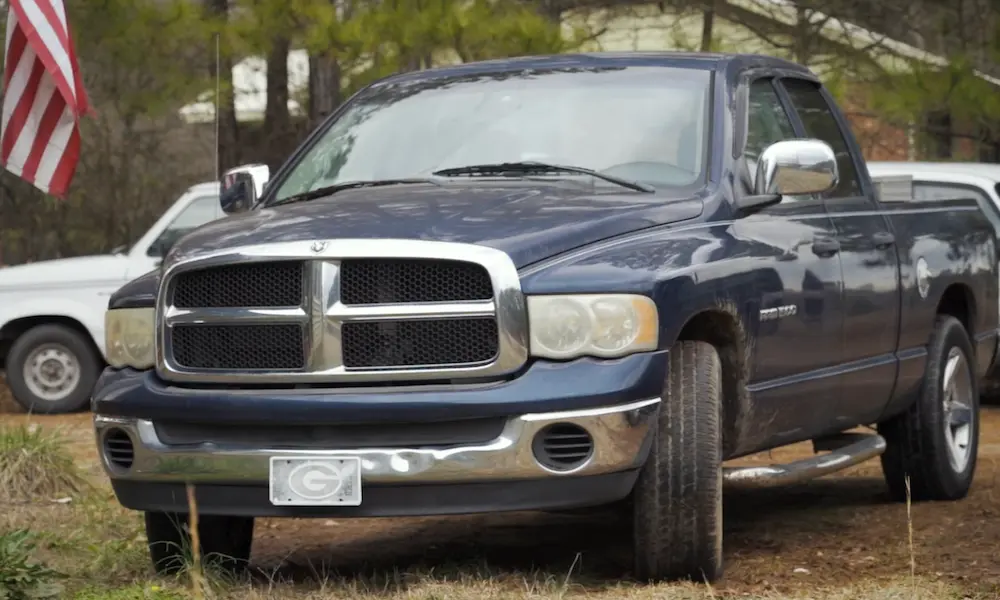Is your Dodge Ram feeling sluggish or showing that frustrating “Service Electronic Throttle Control” warning? There’s a good chance your truck’s throttle position sensor needs resetting. This simple procedure can solve common issues without an expensive trip to the mechanic. Let’s dive into the step-by-step process to get your Ram running smoothly again.
What is a Throttle Position Sensor and Why Does it Need Resetting?
The throttle position sensor (TPS) in your Dodge Ram plays a crucial role in your truck’s performance. It communicates the position of your accelerator pedal to the engine control unit (ECU), telling your engine exactly how much power to deliver when you press the gas.
When this sensor gets out of calibration, several problems can emerge:
- Sluggish acceleration
- Rough idling
- Poor throttle response
- “Service Electronic Throttle Control” warning
- Engine stalling
- Jerking during acceleration
- Check engine lights
These symptoms often appear after battery disconnection, throttle body cleaning, or simply due to normal wear and tear. The good news? You can often fix these issues with a simple reset procedure.
How to Know Your TPS Needs a Reset
Before grabbing your tools, make sure your throttle position sensor actually needs resetting. You’ll likely need a reset if:
- Your gas pedal feels unresponsive
- The engine stalls unexpectedly
- Acceleration is inconsistent or jerky
- You see the “Service Electronic Throttle Control” warning
- You recently disconnected the battery
- You’ve cleaned or replaced the throttle body
If you’re experiencing any of these symptoms, it’s time to try one of the reset methods below.
Method 1: The Pedal Dance Reset (No Tools Required)
This simple method works for most modern Ram trucks and requires nothing but your key and about 5 minutes of your time.
Step 1: Park your truck in a safe location and turn the engine completely off.
Step 2: Insert your key and turn it to the “ON” position without starting the engine (typically two clicks of the key).
Step 3: Wait for all dashboard warning lights to cycle on and off (about 3 seconds).
Step 4: Perform the pedal sequence:
- Slowly press the gas pedal all the way to the floor (take about 4 seconds)
- Hold the pedal fully pressed for 3-5 seconds
- Slowly release the pedal (take about 4 seconds to fully release)
- Repeat this entire press-hold-release sequence two more times (3 total cycles)
Step 5: Turn the ignition to OFF and remove the key.
Step 6: Wait about 10 seconds, then start the engine and let it idle for a couple of minutes.
Step 7: Test the throttle response by gently pressing the accelerator to verify the reset worked.
This method is particularly effective for 2011-2018 Ram trucks with the 5.7 Hemi engine. Many Ram owners report immediate improvement in throttle response after performing this simple reset.
Method 2: Battery Disconnect Reset
If the pedal dance method didn’t solve your problem, the battery disconnect method offers a more thorough reset by completely clearing the ECU’s memory.
Step 1: Park safely, turn off the engine, and let it cool down.
Step 2: Open the hood and locate the battery.
Step 3: Using a wrench, loosen and remove the negative (black) terminal cable. Be careful not to let the cable touch any metal surfaces.
Step 4: Leave the battery disconnected for 5-10 minutes to ensure all electrical charge drains from the system.
Step 5: Reconnect the negative terminal and tighten the connection securely.
Step 6: Turn the ignition to ON (without starting) and wait about 30 seconds for the ECU to run system checks.
Step 7: Start the engine and let it idle for 10-15 minutes without touching the gas pedal. This allows the ECU to relearn proper throttle position and airflow data.
Step 8: Take a short drive to help the ECU fine-tune throttle response under actual driving conditions.
This method is particularly effective for vehicles with electronic throttle control systems when simpler resets don’t work.
Method 3: OBD2 Scanner Reset (Most Accurate)
For the most reliable reset, especially on newer Ram models with advanced engine control systems, an OBD2 scanner offers direct communication with your truck’s computer.
What You’ll Need:
- OBD2 scan tool that supports throttle relearn or idle learn functions
Step 1: Locate the OBD2 port (usually under the dashboard near the steering column) and plug in your scanner.
Step 2: Turn the ignition to ON without starting the engine.
Step 3: Navigate the scanner menu to select your vehicle model, then find “System Tests,” “Service Functions,” or “ECU Functions.”
Step 4: Look for options like “Throttle Position Reset,” “Accelerator Pedal Relearn,” “Idle Relearn,” or “ETC Reset.”
Step 5: Follow the on-screen prompts, which may involve cycling the ignition or starting the engine.
Step 6: The scanner will confirm successful reset. Remove the scanner, start the engine, and let it idle before taking a test drive.
This method provides the most comprehensive reset and is worth trying if the simpler methods don’t resolve your issues.
Important Fuse Checks Before Resetting
Before attempting any reset procedure, it’s worth checking specific fuses that commonly cause throttle control problems in Dodge Ram trucks.
The main engine fuse box contains several critical fuses related to the electronic throttle control system, including numbers 6, 21, 22, 26, 57, 63, 64, 72, 76, 78, and 79. A blown fuse in any of these positions can trigger the “Service Electronic Throttle Control” warning and cause throttle-related issues.
| Fuse Number | Function | Common Issues When Blown |
|---|---|---|
| 6 | Throttle Control Module | No throttle response, service warning |
| 21 | Engine Control Module | Engine performance issues, stalling |
| 22 | Throttle Power Supply | Erratic throttle behavior |
| 26 | Throttle Signal | Slow or no throttle response |
| 57 | Instrument Cluster | Warning lights, no speedometer |
| 63-79 | Various Engine Systems | Multiple engine performance issues |
Checking and replacing these fuses is an easy first step that might save you from more complicated procedures.
Model-Specific Considerations
While the reset procedures outlined above work for most Dodge Ram model years, there are some important variations to be aware of:
2011-2018 Ram Trucks
For these models, especially those with the 5.7 Hemi engine, the basic ignition reset method (pedal dance) is typically most effective. Some forum users report success with a simplified version: turn the key to ON, wait for warning lights to cycle off, slowly depress the throttle to the floor and hold for 3-5 seconds, then slowly release and turn the ignition off.
Older Ram Models (Pre-2010)
Older models may respond better to the battery disconnect method, as their ECU systems often benefit from a complete memory purge.
Diesel Ram Models
Diesel-powered Rams often require a slightly longer idle period during relearn procedures. After performing any reset method, allow the engine to idle for at least 15-20 minutes for proper calibration.
Troubleshooting When Resets Don’t Work
If you’ve tried all reset procedures and still have throttle issues, consider these additional steps:
1. Verify Electrical Connections Make sure all electrical connections to the throttle body are secure and free from corrosion.
2. Check for Diagnostic Trouble Codes Use an OBD2 scanner to check for specific error codes. Codes starting with P0120 through P0129 typically relate to throttle position sensor issues.
3. Inspect the Throttle Body Carbon buildup on the throttle body can cause erratic behavior. A careful cleaning might be necessary.
4. Test Related Sensors The Mass Airflow Sensor (MAF) and other related sensors can mimic TPS issues when they fail.
5. Check for Technical Service Bulletins (TSBs) Some Ram models have known throttle control issues addressed by manufacturer bulletins. Check the NHTSA database for any applicable recalls or TSBs for your specific model year.
Maintenance Tips to Prevent Future TPS Problems
Prevention is always better than cure. Here are some maintenance tips to keep your throttle position sensor working properly:
Regular Throttle Body Cleaning Clean your throttle body every 20,000-30,000 miles. Use only specialized throttle body cleaner, not carburetor spray or gasoline, which can damage components. Always perform a TPS reset after cleaning.
Battery Maintenance Keep your battery terminals clean and connections tight. Battery voltage issues can affect the electronic throttle control system.
Quality Fuel Using higher-quality fuel with detergent additives helps prevent carbon buildup that can affect throttle operation.
Air Filter Replacement A clean air filter ensures proper airflow to the throttle body. Replace according to your truck’s maintenance schedule.
Proper Driving Habits Avoid driving with a nearly empty gas tank, as sediment can be drawn into the fuel system, potentially affecting throttle control components.
A Complete Throttle Reset Table
| Reset Method | Time Required | Tools Needed | Best For | Success Rate |
|---|---|---|---|---|
| Pedal Dance | 5 minutes | None | Routine resets, minor calibration issues | 70-80% |
| Battery Disconnect | 20-30 minutes | Basic wrench | More persistent issues, ECU memory problems | 80-90% |
| OBD2 Scanner | 10-15 minutes | OBD2 scanner with relearn function | Complex issues, newer models | 95%+ |
When to Replace Your Throttle Position Sensor
Sometimes a reset won’t fix the issue because the sensor itself has failed. Consider replacement if:
- Multiple reset attempts fail to resolve the issue
- You’ve verified the problem with diagnostic codes specific to the TPS
- The throttle response is erratic even after cleaning and resetting
- You notice physical damage to the sensor or wiring
A new throttle position sensor typically costs between $75-150, plus labor if you don’t install it yourself. For most Ram models, this is a relatively straightforward DIY job that can save you significant money compared to dealership rates.
Preventing Throttle Position Sensor Issues
The electronic throttle control system in your Dodge Ram is sophisticated but sensitive to environmental factors. Here are some tips to prevent issues:
- Avoid driving through deep water or muddy conditions that could contaminate the throttle body
- Don’t use harsh chemicals near the throttle body when cleaning your engine bay
- Keep battery connections clean and tight to prevent voltage fluctuations
- Follow the manufacturer’s recommended maintenance schedule
- Address check engine lights promptly before small issues become bigger problems
By following these reset procedures and maintenance tips, you can keep your Dodge Ram’s throttle position sensor working properly for years to come. Most throttle issues can be resolved with these simple DIY methods, saving you time and money on professional repairs.














